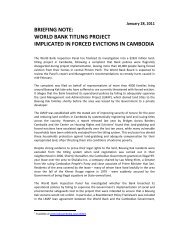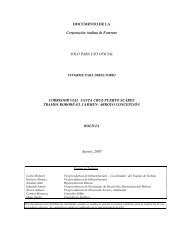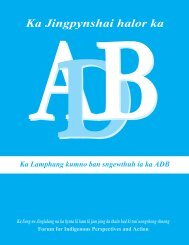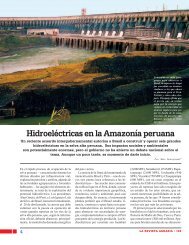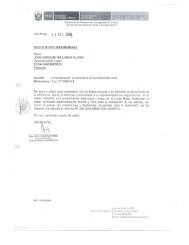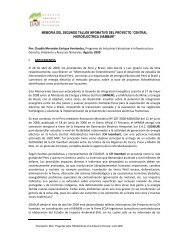The Real Cost of Power - Bank Information Center
The Real Cost of Power - Bank Information Center
The Real Cost of Power - Bank Information Center
You also want an ePaper? Increase the reach of your titles
YUMPU automatically turns print PDFs into web optimized ePapers that Google loves.
Possible factors contributing to the drastically reducing fish catch in this area over the last few years can be identified<br />
as follows:<br />
One <strong>of</strong> the major factors identified by almost all was the destruction <strong>of</strong> creeks and mangroves (with the Adanis<br />
contributing on a much larger scale), which are nurseries <strong>of</strong><br />
<br />
marine life, as described earlier in this report. Both the Kothdi<br />
and Mudhwa creeks have been badly damaged by Tata's<br />
dredging, widening, and denudation.<br />
Another major factor identified by the fishing community is the<br />
thermal pollution from the power plants – the warm cooling<br />
“<strong>The</strong> power plant will have a oncethrough<br />
cooling system using<br />
seawater. <strong>The</strong> seawater requirement<br />
will be about 15.12 million cubic<br />
3<br />
meters per day (m /day) <strong>of</strong> which<br />
water coming out <strong>of</strong> their outfall channels.<br />
This is a very large<br />
3<br />
about 14.99 million m /day will be for<br />
volume <strong>of</strong> warm water mixing with the Gulf water here. <strong>The</strong> condenser cooling and 0.1278 million<br />
CGPL claimed that they have permission from the Ministry <strong>of</strong><br />
3<br />
m /day for producing freshwater. <strong>The</strong><br />
Environment and Forests to discharge cooling water at 7⁰C above seawater will be pumped at the end <strong>of</strong><br />
ambient. However, there was no document available to show an inlet channel connecting to Kotdi<br />
that the Environmental Clearance given by the Ministry <strong>of</strong><br />
Creek. <strong>The</strong> spent cooling water,<br />
Environment and Forests on March 2, 2007 in which, a closed warmed to about 7 degrees Celsius<br />
cycle cooling system was a precondition (against an open cycle (°C) above ambient sea water<br />
<br />
cooling system which the company is operating now), was<br />
amended.<br />
In such a sensitive area, this will have a huge negative impact.<br />
temperature, will be discharged back<br />
into the sea through a discharge<br />
channel opening to Mudhwa Creek.”<br />
This is also a violation <strong>of</strong> their environmental clearance, which<br />
was for a closed cycle cooling system. <strong>The</strong> adjacent Adani super<br />
mega coal power plant is building its so-called closed cycle<br />
From Tata EIA<br />
<br />
cooling system with an array <strong>of</strong> forced-draft cooling towers visible, reducing required cooling water volume by<br />
nearly 90%. <strong>The</strong> failure <strong>of</strong> the Tata Mundra plant to adopt a closed-cycle cooling system, as permitted, raises<br />
concerns as to whether they are cutting corners in order to increase pr<strong>of</strong>its. Further, no cumulative impact<br />
studies were done to ascertain the impacts <strong>of</strong> warm water from all these power plants in this small area.<br />
<strong>The</strong> other likely impact <strong>of</strong> warm water is de-oxygenation – as a result <strong>of</strong> the increased temperature in the areas<br />
around the cooling water discharge, the dissolved oxygen level in the water is likely to go down, affecting all<br />
kinds <strong>of</strong> marine life very badly. This has a direct consequence for communities dependent on marine resources<br />
in these coastal areas. This has not been taken into account by the company.<br />
Another possibility pointed out by the marine scientist in the fact-finding team was the possible death <strong>of</strong> large<br />
numbers <strong>of</strong> fish seedling with the pumped intake water,<br />
unless high technology special filters are used. <strong>The</strong><br />
th<br />
fact-finding team specifically asked the CGPL management about this on their meeting in their <strong>of</strong>fice on 19 May<br />
afternoon, but the CGPL could not give any specific information, giving us the impression that in all likelihood<br />
they are not using any such screening device. It may be noted here that while in most countries IFIs insist on<br />
such safeguards – with US EPA documents indicating that any intake rate over 2 million gallons/day should<br />
follow those safeguards – no such conditions were set forth by them here. “….2 million gallons per day intake<br />
threshold, over which facilities fall under this rule. <strong>The</strong> literature indicates that the mortality due to impingement<br />
11<br />
and entrainment increase dramatically above this threshold.”<br />
<strong>The</strong> CGPL's proposed intake rate at full capacity<br />
3<br />
is 15.12 million m /day, or about 3,994 million gallons/day, about 2,000 times the high-damage threshold!<br />
Even with just one unit operational, this is higher than the high-mortality threshold by nearly 400 times!<br />
<strong>The</strong> possibility that chemical pollution is also being discharged along with the cooling water, causing change in<br />
the chemical property <strong>of</strong> the water, is detailed later. This is indicated, as stated, by the persistent frothiness.<br />
<strong>The</strong> highly salinated brine, discharged from the desalination plant <strong>of</strong> the power project, might also be<br />
increasing the salinity/changing the pH <strong>of</strong> the water, driving fish away. As the Tata EIA says, “Rejects from the<br />
desalination plant will be discharged into the sea through the discharge channel <strong>of</strong> the cooling water system,”<br />
and this is a substantial volume <strong>of</strong> brine (reject) added to the gulf shores everyday.



